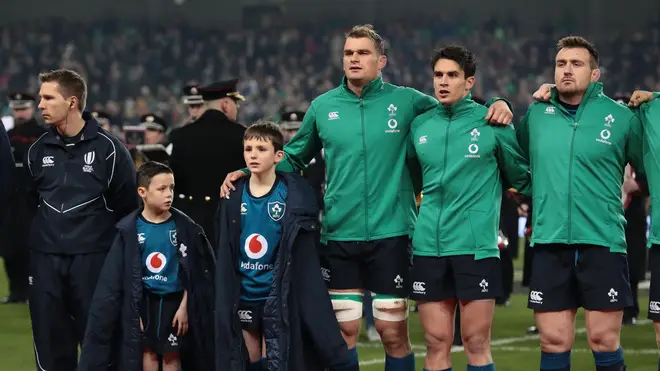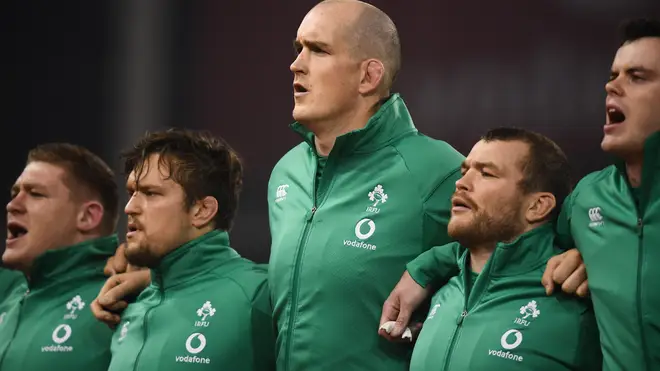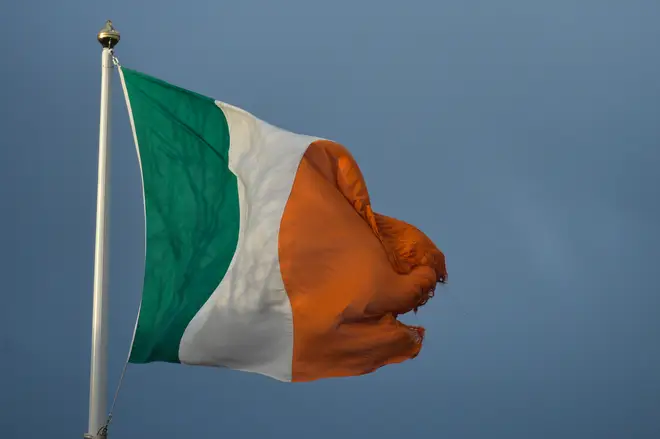On Air Now
The Classic FM Hall of Fame with Anne-Marie Minhall 12pm - 3pm
20 July 2023, 11:51 | Updated: 18 September 2023, 16:28

The national anthem of Ireland, ‘Amhrán na bhFiann’, originally written in English but later translated into Irish, was adopted in 1926.
Ireland’s national anthem ‘Amhrán na bhFiann’, known in English as ‘The Soldier’s Song’, was composed in the early 1900s, on a melodeon.
Today, Irish sports teams often sing a different anthem, ‘Ireland’s Call’ either alongside, or instead of, ‘Amhrán na bhFiann’.
Here’s everything you need to know about Ireland’s national anthem, from its lyrics to why we sometimes hear two different anthems.
The best national anthems ever written >
Sinne Fianna Fáil,
Atá faoi gheall ag Eirinn,
Buíonn dár slua, thar toinn do ráinig chugainn,
Faoi mhóid bheith saor, seantír ár sinsear feasta
Ní fhágfar faoin tíorán ná faoin tráill;
Anocht a théam sa Bhearna Baoil
Le gean ar Ghaeil chun báis nó saoil,
le gunnaí scréach, trí lámhach na bpiléar,
Seo dhíbh canáigh, Amhrán na bhFiann.
Soldiers are we,
Whose lives are pledged to Ireland,
Some have come from a land beyond the wave,
Sworn to be free, no more our ancient sireland
Shall shelter the despot or the slave;
Tonight we man the Bearna Baoil
In Erin’s cause come woe or weal,
‘Mid cannon’s roar and rifle’s peal,
We’ll chant a soldier’s song.
The song has three verses, but only the above chorus is used as the country’s official national anthem.

Ireland’s national anthem, ‘Amhrán na bhFiann’, in English ‘The Soldier’s Song’, was written by childhood friends, Peadar Kearney and Patrick Heeney, between the years 1909 and 1910.
While Heeney composed the melody on his melodeon, Kearney wrote the text.
Kearney’s original lyrics, written entirely in English and beginning, “We’ll sing a song, a soldier’s song”, are largely unused today.
In 1923, an Irish translation was penned by Liam Ó Rinn, which is the version Irish players sing today. The Irish version was officially adopted as the national anthem in 1926, following calls for a united approach to the national anthem.
Before that, for hundreds of years Irish people had ‘God Save the King/Queen’ as their national anthem.
Read more: What are the lyrics to ‘God Save the King’, Britain’s national anthem?
‘Amhrán na bhFiann’ is steeped in a complex history, its lyrics telling of Ireland’s fight against a foreign enemy, and arousing sensitivities among ex-unionists in Ireland.
During the War of Independence between 1919 and 1921, ‘Amhrán na bhFiann’ was adopted by Sinn Féin and for a while, was known as the ‘Sinn Féin anthem’.
As the anthem was banned by British forces, its popularity grew, and it was decided that it was the right anthem for the new Free State.
Today, the Ireland rugby team is made up of players from both the Republic of Ireland and Northern Ireland, whose official anthem is ‘God Save the King/Queen’.
Ahead of the 1995 Rugby World Cup in South Africa, the Irish Rugby Football Union decided to commission a new song, given several of its members were from Northern Ireland and considered the use of the Republic’s anthem appropriate.
Ireland players now often sing Phil Coulter’s ‘Ireland’s Call’ at international matches. At some games, players sing along to ‘Ireland’s Call’, with ‘Amhrán na bhFiann’ left as an instrumental number.
Read more: What are the lyrics to the Welsh National Anthem – and what do they mean?

Northern Ireland’s official national anthem is ‘God Save the King’, but there are some variations including at the Commonwealth Games, where ‘Londonderry Air’ is used as the Northern Irish team’s victory anthem.
When Northern Irish players compete alongside players from the Republic of Ireland as one team, they all sing ‘Ireland’s Call’.
Have a listen to both songs below:

Passionate Ireland's Call Anthem

Irish national anthem